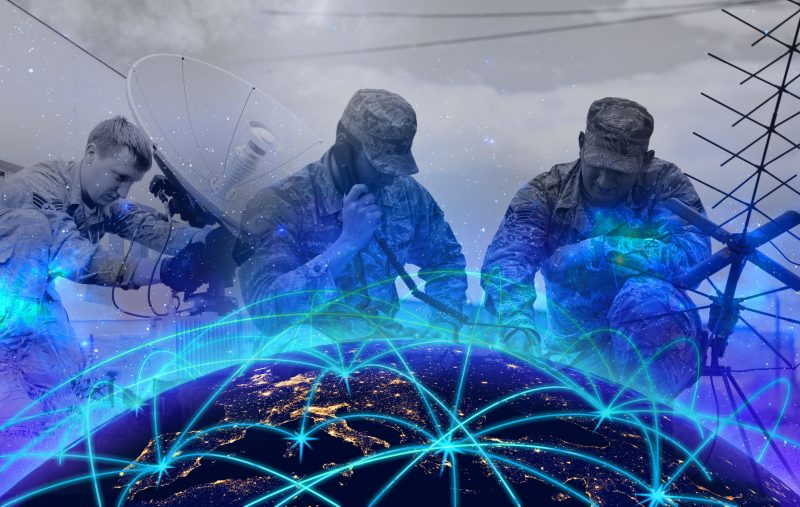US Space Force Completes Analysis of Future GMTI Alternatives, Including Space-Based GMTI

Via Satellite illustration
The U.S. Space Force has completed an analysis of alternatives (AoA) on future ground moving indication (GMTI), including the possibility of space-based GMTI, to replace the Northrop Grumman E-8C Joint Surveillance Target Attack Radar System (Joint STARS) GMTI planes.
“Moving target indicator — that’s force design work we’ve been doing over the last year,” Chief of Space Operations Gen. John “Jay” Raymond told reporters at the Air & Space Forces Association conference on Sept. 21. “We have just completed the AoA on that work to determine how best to do that from a multi-domain perspective, and we’re in the process of outbriefing those results.”
One of Air Force Secretary Frank Kendall’s operational imperatives has been the provision of GMTI at scale.
Last month, National Reconnaissance Office (NRO) Director Chris Scolese said that the NRO and the Department of the Air Force have been collaborating on a Space-Based Radar study continues to fulfill that operational imperative.
Scolese said that NRO plans to take advantage of commercial radar services, where possible. In January, the NRO announced the award of five commercial radar contracts to Airbus, U.S.; Capella Space; Iceye U.S.; PredaSAR; and Umbra Lab.
To inform next year’s fiscal 2024 budget request, the Space Force’s Space Warfighting Analysis Center (SWAC) has worked on a force design for future GMTI using a possible mix of space and air assets.
The SWAC investigated future GMTI force design as the center’s second priority force design. SWAC delivered its first force design on hypersonic missile warning and tracking — a proposed mix of Low- and Medium-Earth Orbit satellites — in January.
“Certainly, space-based radar is critical for anything that we do,” Scolese said last month. “The Earth gets cloudy at times, and radar certainly gives us an advantage there. Clearly, radar is absolutely critical to any ISR activity that one would do or wanted to understand what’s going on on the ground. Commercial plays a role in that. National systems play a role in that, and we’re evaluating all of them to inform our decisions as we go forward on moving target indication or any other activity that would involve our understanding of what’s happening on the surface of the Earth.”
The Department of the Air Force wants to retire its 12 remaining Joint STARS — eight in fiscal 2023 and four in fiscal 2024 — and to use other intelligence, surveillance, and reconnaissance (ISR) assets to fill in for the loss of Joint STARS. The Air Force has said that Joint STARS is too costly to continue to operate, and the NRO and the Air Force have said that space-based GMTI will prove valuable in ground detection and monitoring over countries with advanced means to deny the flight of U.S. ISR aircraft.
The NRO is “launching more capable systems, employing different phenomenologies to thwart denial — either by camouflage or other means,” Scolese said last month.
Dynamic GMTI radars, as on Joint STARS, allow periodic updates and precise tracking of moving ground targets via the Doppler returns of such targets.
The Air Force has said that it continues “to operate multiple ISR platforms with GMTI capability and plan to do so across the duration of the coverage reduction caused by JSTARS retirement.”
Other Air Force aircraft besides Joint STARS with GMTI include the U-2 with the Raytheon Technologies ASARS-2 radars, the Northrop Grumman RQ-4 Block 40 Global Hawk with the Raytheon AN/ZPY-2 radar, and the RQ-170 Sentinel by Lockheed Martin. The Advanced Battle Management System (ABMS) — the Department of the Air Force initiative under Pentagon Joint All Domain Command and Control (JADC2) — is to aid the integration of such sensor information for targeting.
In addition to Air Force GMTI, other services have some GMTI. For example, the U.S. Navy MQ-4C Triton aircraft by Northrop Grumman has GMTI, while the U.S. Army De Havilland Canada (DHC) Airborne Reconnaissance Low aircraft have GMTI. In addition, Leidos has been working with the Army on possible GMTI on a modified Bombardier 650 business jet that Leidos owns. While the 1948 Key West Agreement and its modifications carving out service mission areas appear to prohibit Army aerial reconnaissance jets, the stipulations may contain a loophole for contractor-owned test assets.
Lt. Gen. William Liquori, the deputy chief of space operations for strategy, plans, programs, requirements, and analysis, said in June that he believes future GMTI will feature “a combination of assets” but that “there’s absolutely a role for space, and the trick for us in this force design, like with all of them, is we’ve got to be able to find a way to do this that meets the laws of physics in the domain, that does it in a resilient fashion, and we’ve got to be able to do it in a fashion that’s affordable to be able to do within our budget space that we have.
“That’s no easy task,” he said. “There are still several steps to go before we get there, but we’re committed to do it because we know the importance of it.”
While DoD has pointed to China’s formidable air defenses as a deterrent to manned surveillance aircraft, large numbers of stealthy and non-stealthy surveillance drones may be another alternative for replacing Joint STARS.
This article was first published by Via Satellite sister outlet Defense Daily.